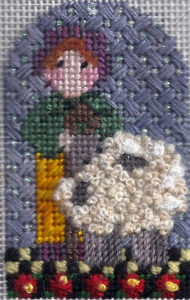
Another fon way to stitch sheep effectively is to use French Knots. While using French Knots to make fleece iusn’t a novel idea, I’ve refined the process to make it easier and more realistic. The Needledeeva canvas pictured above uses this technique.
Before starting the fleece, be sure to stitch all the other parts of the stitch. Here I used Tent for the face and Oblique Continental on the legs.
To stitch the fleece, you’ll need three shades of wool. The lightest should be a bright white. The middle shade should be cream. The final color should be very light tan (used in picture) or very light grey. The model uses Gloriana Lorikeet.
The first step is to use the darkest white and a thinner than usual thread to stitch the entire fleece with SKIP TENT, below. The purpose of this step is to create an underpinning for the knots. The stitching creates natural shadows. It also allows you to space the knots a bit more loosely. That allows the individual knots to shine. The result is more realistic fleece that looks like sheep, not like poodles.

The next step is to decide where the light will be hitting the sheep. Based on this, divide the fleece into two irregular halves without a straight line dividing them. On the side away from the light source, use the darkest color of white to make knots on that side. Be sure to keep the dividing line uneven. Also leave out a few knots near the edge for knots in the other color.
Once these knots are completed, add just a few knots near the edge but on the light side of the fleece. Scattering these knots and having the uneven dividing line, smudges the division between the colors and makes the transition realistic.
Stitch a few knots in the middle color in the open spaces in the darker area. If you didn’t leave space for them, just squeeze them in — only a few are needed!
Using the middle shade stitch the second half of the fleece. Doing this creates a stitched fleece.
The last step is to create a highlight where the light hits the sheep, using the bright white wool. On top of the other knots and at the light source, add a highlight of just a few knots using the lightest color.
You can control the size of your knots so that the match the size of your sheep. Do this by changing the size of the needle, the width of the thread, how many wraps you use, and how tightly you wind.
Unlike Fluffy Fleece, this technique works beautifully for smaller sheep or more delicate designs.
About Janet M Perry
Janet Perry is the Internet's leading authority on needlepoint. She designs, teaches and writes, getting raves from her fans for her innovative techniques, extensive knowledge and generous teaching style. A leading writer of stitch guides, she blogs here and lives on an island in the northeast corner of the SF Bay with her family

Leave a Reply